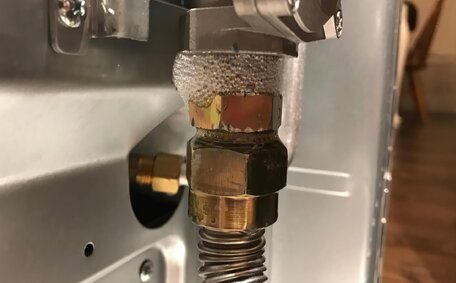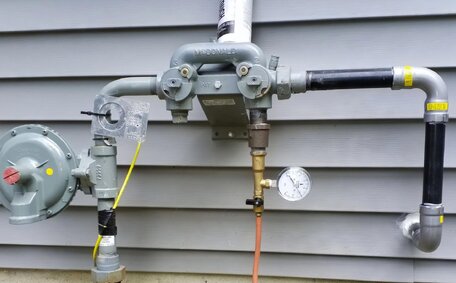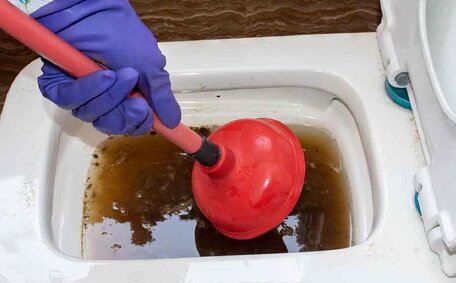Understanding Your Hot Water System
Hot water systems are crucial for daily household activities, such as bathing and cooking. In Kenthurst, homeowners typically use one of the following hot water systems:
- Electric storage water heaters use electricity to warm water in an insulated tank, keeping it ready for use.
- Gas storage water heaters use natural gas or LPG to heat water stored in an insulated tank.
- Heat pump water heaters extract heat from ambient air to heat water stored in an insulated tank.
- Solar water heaters use energy from sunlight to heat water that is stored in an insulated tank.
As hot water heating constitutes about 21% of household energy consumption, efficient thermostat management is imperative. Doing so minimises energy waste and cuts costs while satisfying your hot water requirements.
Key Components of a Hot Water System
A hot water system has several key components that work together to heat and deliver hot water:
- Storage tank - An insulated container that holds hot water, significantly reducing heat loss.
- Heating element - Electric heating rods or a gas burner that heats the water.
- Thermostat - Controls the temperature set point to heat water to the desired temperature.
- Relief valve - Safety valve that opens if pressure or temperature get too high.
- Pipes and plumbing - Carry hot water to fixtures and cold water back to the tank.
- Anode rod - Metal rod that protects inner tank from corrosion.
Knowing the function of each component is crucial for the proper maintenance of your hot water system. The thermostat is especially important as it regulates the system’s temperature, promoting both efficiency and safety.
Determining the Ideal Temperature for Efficiency
To reduce unnecessary energy consumption, setting your hot water system’s thermostat at the right temperature is crucial. This strategy diminishes heat loss and optimises efficiency. A balance between conserving energy and maintaining safety is essential to prevent bacterial growth.
Experts recommend setting a continuous flow system’s thermostat to no higher than 50 degrees Celsius, This not only curbs energy waste but also inhibits harmful bacteria like Legionella.
For a storage tank system, the thermostat should be set to at least 60 degrees Celsius. This hotter temperature helps kill bacteria in the water stored in the tank.
Regardless of the system, the recommended practice is to use the lowest safe temperature that meets your hot water requirements. Lowering the temperature by 10 degrees Celsius can reduce water heating energy usage by as much as 5%, yielding cost savings.
Recommended Temperatures by System Type
Optimal thermostat settings differ based on the type of hot water system you have:
- Electric water heaters - Maintain a setting of 60-70°C to inhibit bacterial growth and minimise heat loss.
- Gas storage water heaters - For optimal efficiency and safety, set your thermostat between 60-65°C.
- Continuous flow gas heaters - A maximum of 50°C delivers hot water without excessive energy use.
- Solar water heaters - 60°C is optimal if you have electric backup.
- Heat pump systems - Set the temperature between 50-55°C for peak efficiency.
The key is balancing safety and energy savings. Temperatures set too high increase risks of scalding, heat loss, and elevated costs. Ensuring your water stays at a temperature not running higher than necessary can prevent harmful bacteria from multiplying.
Check your system’s manual or seek assistance from a professional, such as Kenthurst Plumbing, to identify your system type and ensure your temperature setting is not unnecessarily high for efficiency.
Adjusting the Thermostat
Modifying your hot water system’s thermostat allows you to control the heating temperature, ensuring both efficiency and safety.
If you have a storage tank gas water heater:
- Locate the access panel on the side of the tank and unscrew it.
- Carefully remove the insulation until you can view the thermostat dial or controls.
- To reduce usage, turn the thermostat down by turning the dial counter clockwise. Turn the thermostat down to align properly with the suggested temperature markings.
- Set to the recommended temperature based on your system type, whether it’s gas, electric, or other. Refer to manufacturer guidelines.
- Replace insulation and access panel once set.
For a continuous flow system:
- Locate the thermostat dial, usually on the front panel of the unit.
- Alter the setting by turning the dial clockwise to increase or counter clockwise to decrease the temperature, as per the manufacturer’s instructions.
While adjusting your water heater’s thermostat, always factor in safety considerations:
- To mitigate the risk of scalding, the maximum temperature should generally not exceed 48-50°C.
- To safeguard against bacteria, the minimum temperature should be 60°C for tank systems and 50°C for tankless systems.
Refer to the user guide and ensure you’re not setting a higher temperature than what is recommended for your specific hot water system. Lowering it by even 5-10 degrees can lead to energy savings. However, ensure you meet minimum safe temperatures.
Step-by-Step Instructions
Adjusting your hot water system’s thermostat is an easy process you can do yourself. Here is a step-by-step guide:
- Locate the thermostat on your system. Refer to your owner’s manual if unsure. On a tank water heater it will be under a metal access panel. On a tankless model it is usually on the front.
- If your system is a storage tank model, unscrew the access panel with a screwdriver and cautiously remove the insulation to reveal the thermostat.
- Identify the temperature markings next to the thermostat dial. Also locate any warning stickers for maximum safe temperatures to avoid scalding.
- Adjust the thermostat dial carefully, aligning it with the correct temperature markings for efficiency. Turn clockwise to increase temperature. Counter clockwise lowers it.
- Tank systems should be set to 60-70°C. Tankless systems are best around 50°C. Refer to your system’s manual.
- Once adjusted, replace insulation and access panel if applicable.
- Verify new temperature setting with a thermometer after allowing time for water to reheat fully.
- Contact Kenthurst Plumbing if you have any uncertainty about adjusting your hot water system’s thermostat.
Lowering your thermostat can conserve energy and save money while safely satisfying your hot water needs. But maintain minimum safe temperatures - especially for tank systems where bacteria can grow.
Enhancing Efficiency Through Maintenance
Regular maintenance could improve your hot water system’s efficiency and prolong its service life. Simple biannual tasks like flushing your pressure relief valve can prevent issues down the track.
Consider the following essential maintenance tips:
- Flush the relief valve - Open the relief valve drain line twice a year to clear sediment and ensure it isn’t stuck shut.
- Inspect anodes - Check the magnesium or aluminium anode rod every 2-4 years as they corrode over time. Replace if worn.
- Clear inlet filters - For tankless systems, clean the inlet water filters annually to maintain flow.
- Check pipes and valves - Inspect pipes, fittings and valves biannually for leaks or corrosion and repair any issues.
Preventative maintenance extends your hot water system’s lifespan, efficiency and keeps repair bills at bay. For maintenance assistance, contact the licenced professionals at Kenthurst Plumbing today.
Insulating Pipes and Tanks
Insulation of hot water pipes and tanks is a highly effective method for boosting efficiency. Heat loss through exposed pipes and tanks can account for as much as 25% of a system’s energy usage.
Start by insulating pipes in unheated areas like crawl spaces, outdoor routes, attics and garages. Employ high-quality pipe insulation made specifically for hot water plumbing. Ensure all fittings, elbows and joints are fully covered.
For storage tank water heaters, refer to the owner’s manual to guide you on proper insulation procedures. Wrapping tanks with an insulation blanket rated for the temperature helps retain heat and reduce standby losses.
Properly insulating pipes and hot water storage tanks reduces heat loss, lowers energy bills by 4-16% annually, and improves your system’s efficiency.
Implementing Water Conservation Habits
Practising water conservation at home can significantly reduce your hot water usage, thereby saving energy and lowering utility bills. Here are some simple hot water-saving habits to implement:
- Take shorter showers of 5 minutes or less. Install a water-efficient showerhead if yours is more than 10 years old.
- Fix leaks immediately - whether it’s a dripping faucet or running toilet, leaks waste huge volumes of hot water over time.
- Only use hot water when necessary - cold water works fine for most laundry loads, handwashing dishes, and other cleaning tasks.
- Turn down the temperature on your water heater thermostat even a few degrees to save on heating costs.
- Insulate your hot water pipes to minimise standby heat losses as hot water sits in pipes.
Installing water-efficient fixtures, curtailing shower times, fixing leaks swiftly, and judicious hot water use can slash annual water heating costs by 15-30%.
Upgrading Your Hot Water System
There are several signs indicating your hot water system may need an upgrade:
- Frequent breakdowns and repairs
- Rusting tanks or signs of leakage
- Inadequate hot water supply to meet household needs
- Steep energy bills resulting from system inefficiency
- System is over 10 years old (typical lifespan)
Upgrading an aged, inefficient hot water system to a new energy-efficient model can provide better performance, lower operating costs, and increased reliability.
High efficiency systems now available include heat pump, tankless continuous flow, and solar water heaters. Your licenced technician from Kenthurst Plumbing can advise on the most suitable replacement to meet your household’s hot water requirements while saving energy.
We handle the entire replacement process including permit and paperwork filing, old system removal, new installation, and all plumbing modifications required. Contact our team today for a quote on upgrading your hot water system.
When to Call a Professional
While managing your hot water system’s thermostat can be a DIY job, certain issues signal it’s prudent to call in a professional plumber for service:
- You are unable to locate or access the thermostat on your unit
- After adjustments, the set temperature and actual water temperature do not align
- The system fails to heat water to the desired set point
- There are error codes or other unusual alerts from the system display/interface
- There are leaks, strange noises or other abnormal operation
- Your thermostat has broken or failed
Our licenced plumbers at Kenthurst Plumbing have the skills to troubleshoot any hot water system issues. We can:
- Accurately set your thermostat for optimal efficiency
- Diagnose and repair thermostat failures
- Replace faulty or broken thermostat parts
- Adjust elements, valves, sensors and other components
- Update outdated systems for maximum energy savings
To schedule dependable hot water system service, contact Kenthurst Plumbing at 1300 349 338. Alternatively, email us at [email protected] and we’ll get back to you within a day.






